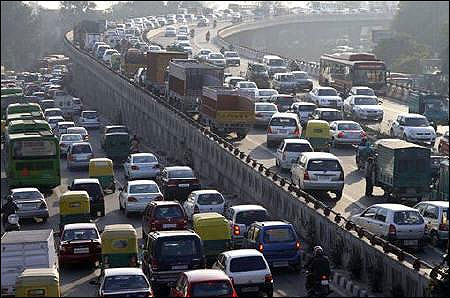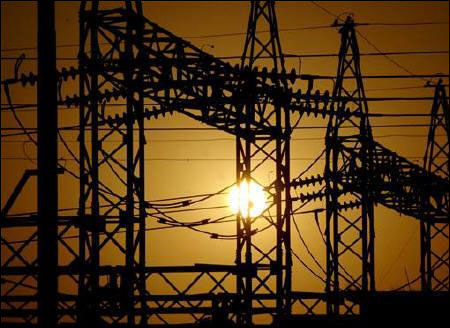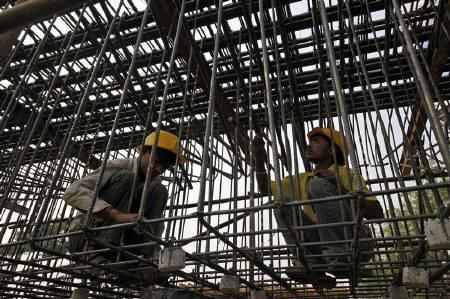Photographs: Amit Dave/Reuters Akash Prakash
Current players lack credibility and money, banks are risk-averse, and equity markets will hammer new entrants
India has one of the most ambitious public-private partnership programmes for infrastructure in the world.
The private sector accounted for 30 per cent of all investment in infrastructure in the last Plan period and is supposed to mobilise 50 per cent ($500 billion) of the planned infrastructure spending for 2012-17.
Since it lacks resources, the Indian government has no option but to hope that the private sector steps up to the plate.
This is because, given its deepening fiscal crisis, the state has no ability to fill this gap.
How realistic is this expectation?
. . .
Who will build India's infrastructure?
Photographs: Arko Datta/Reuters
Let's begin by asking where the equity capital will come from.
I have pointed out earlier that the equity markets are unwilling to fund the current infrastructure developers in any meaningful way.
Of all the current major participants in the infrastructure space, only a handful of players, such as Jindal Steel and Power Limited ($ 5 billion), Tata Power ($4 billion) and Adani ($4 billion), have meaningful market capitalisations, of a few billion dollars.
The rest of the former poster boys of the infra boom of 2007 have market values of less than a billion.
How will this lot raise enough money to commission projects of the magnitude the country needs?
. . .
Who will build India's infrastructure?
Photographs: Arko Datta/Reuters
They have neither enough market capitalisation nor the right level of promoter ownership to raise sufficient equity monies.
These stocks have been disasters for investors, with most down 65 per cent from their peak.
The equity capital markets are shut for these companies, and more broadly for infrastructure projects per se.
Investors are convinced that, by and large, infrastructure projects and their developers have negative cash flows, low returns and high leverage -- traits that nobody wants today.
Then we look at the debt side of the equation.
Here both Barclays and Credit Suisse have highlighted the asset quality challenges facing the Indian banking system, specifically in regard to infrastructure.
. . .
Who will build India's infrastructure?
Photographs: B Mathur/Reuters
Over the past five years, Indian banks have witnessed 20 per cent CAGR loan growth, but this growth has been concentrated in a few large corporate groups.
In 2011-12, over 20 per cent of incremental loans were given to just 10 groups (source: Credit Suisse).
The total debt level of these 10 groups (all of whom are the major private-sector players in infrastructure) has jumped five times in the past five years (40 per cent CAGR) and they now account for 23 per cent of all corporate loans and 98 per cent of the banking system's net worth (source: Credit Suisse).
Given the slowing economy, macro weakness and infrastructure sectoral issues, the financials of these 10 are stretched, with average group debt/Ebitda over 7.5, and four of the 10 groups having an interest cover of less than one (source: Credit Suisse).
. . .
Who will build India's infrastructure?
Photographs: Amit Dave/Reuters
These groups are all free cash flow negative and will need to borrow more just to complete projects already in the pipeline.
As Barclays points out, the numbers are no better if you go beyond these top 10 groups and look at the top 40.
Beyond this, surprisingly, India (a market known for vibrant and widespread entrepreneurship) has higher borrowing concentration levels than either Korea or Russia (markets known for having few but very large industrial groups).
The top 10 borrowers in India account for 13 per cent of total banking system loans, compared to 11 per cent in Russia and seven per cent in Korea (source: Credit Suisse).
. . .
Who will build India's infrastructure?
Photographs: Jitendra Prakash/Reuters
Given this concentration level and the poor balance sheets and cash flow profiles of these top 10 groups, it seems unlikely that the Indian banking system can extend further significant incremental credit to this lot.
Yet these top 10 groups account for about 70 per cent of the private sector power capacity that is scheduled to be commissioned by 2017, as well as large chunks of the incremental capacity in roads, ports and airports.
If they can't access equity or debt, will they even be able to complete their current projects, leave alone start new ones?
We as a country obviously need to attract new sources of capital and new players into the infrastructure space.
. . .
Who will build India's infrastructure?
Photographs: Baz Ratner/Reuters
Yet, given regulatory hassles most large PPP projects have gone through and the difficulty in making money in the space, who will come to India or invest capital here?
Financial markets are also dis-incentivising new entrants, as markets will decimate the share price of any company that announces plans to get into this space.
Very few MNCs want to deal with the government and its regulators on a daily basis -- and, given what has happened in telecom, which international board will sanction a big new greenfield infrastructure investment in India?
Those Indian groups who had an interest have already jumped in; for those not in this space, the reasons they stayed away have not changed.
. . .
Who will build India's infrastructure?
Photographs: Reuters
Private equity on its own does not have the capital, patience or skills to make much of a difference.
And do we have a pipeline of ready-to-go projects with clearances, even if funding were available?
There's a fundamental contradiction in this sector.
Our regulators and civil society are hell-bent on ensuring that no project should be allowed to make a windfall return.
Yet, given the risk premium of dealing with the Indian government and its regulatory apparatus, why would anyone commit capital unless they can see a 20 per cent return on equity?
Capital markets will not fund projects, unless they see this type of return profile.
. . .
Who will build India's infrastructure?
Photographs: Danish Siddiqui/Reuters
In a world of generally lower leverage and risk aversion among banks, if we cannot gear up projects with debt/equity ratios of 3:1, like in the past, then project-level, unlevered, returns need to rise.
If a project has to make a 20 per cent ROE, be it a port, road, power plant or an airport, it will have to price its services accordingly -- which does not seem to be acceptable to India's institutional system of checks and balances.
If financial markets are going to fund our infra build-out, they will demand a higher return, hence higher user costs, compared to government funding.
Based on the evidence to date, financial markets are not convinced that infrastructure projects in India will be allowed to make such returns.
Unless we solve this conundrum, money will not flow into this sector of the economy.
. . .
Who will build India's infrastructure?
Photographs: Krishnendu Halder/Reuters
The reality is this: given the above, it seems very challenging to assume that the private sector will deliver $500 billion of completed infrastructure projects.
The current set of private sector infrastructure developers does not have the credibility or balance sheets to fund the needed build-out, and markets will not fund or allow new players in this space till they are convinced around project economics and the regulatory environment.
The public sector has serious challenges on the funding front as well. If we don't figure out how to fix these issues, then I am afraid that economists like Jahangir Aziz of JPMorgan may be right when they talk of India's potential growth rate having dropped to six per cent.
The author is fund manager and CEO of Amansa Capital












article